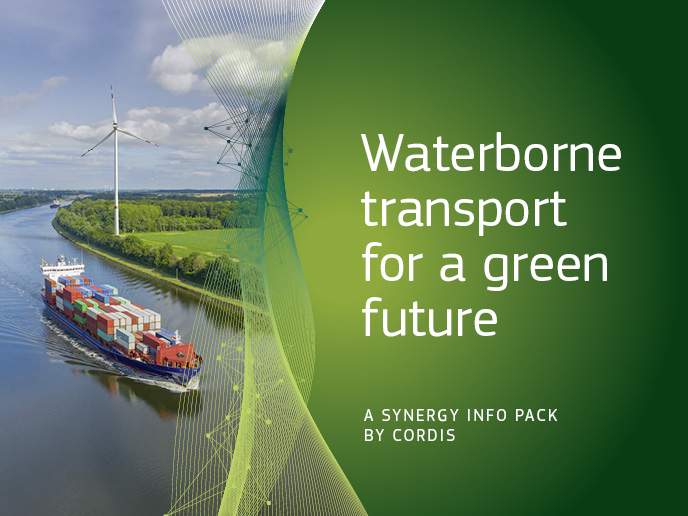Discover the EU-funded projects putting the green into waterborne transport
Waterborne transport is an economic powerhouse – responsible for 77 % of Europe’s external trade and 35 % of the trade happening between EU Member States. It’s also a remarkably efficient mode for getting around, especially compared to road transport. It is estimated that every tonne of freight transferred from road to water results in a four to fivefold reduction in emissions. Yet the sector is responsible for 13.5 % of all transport-related greenhouse gas emissions in Europe. Although this is less than what’s produced by the road transport and aviation sectors (71 % and 14.4 % respectively), it is a substantial carbon footprint, which could increase as demand for shipping grows. Waterborne transport also emits other types of air pollution, including sulfur dioxide and particulates. If Europe is to achieve its Green Deal objective of becoming the world’s first carbon-neutral continent, it must reduce waterborne transport’s environmental impact. But it must do so in a way that facilitates the growth of a modern and globally competitive shipping sector. That’s a difficult balance to strike, but one that the 13 EU-funded research, innovation, implementation and infrastructure projects highlighted in a new Synergy Info Pack on Waterborne Transport are working to achieve.
From wind power to green hydrogen and everything in-between
Managed by CINEA, the projects come from different funding programmes, countries and sectors, but all share a commitment to making waterborne transport more sustainable, more efficient and more competitive. The ‘Energy-saving technologies’ chapter showcases how projects such as Orcelle and SustainSea are installing novel kinds of sails on cargo ships so they can run using the wind. The chapter also talks about how the CO2NTROL project is using technology to help ships identify the most energy-efficient shipping routes. Meanwhile, the ‘Alternative fuels for shipping’ chapter highlights how a number of projects, including HySeas III, FReSMe, POSEIDON and FirstBio2Shipping, are working to power vessels via green hydrogen, recycled carbon, synthetic methanol and bio-LNG.
Reducing pollution and saving whales
Waterborne transport’s environmental impact involves not only carbon emissions, but also air pollution and biodiversity – three topics that the three projects covered in the ‘Environmental protection’ chapter are working to address. On the CO2 front, the TrAM project delivered a fully electric, emission-free fast passenger ferry in Norway, while the CLINSH project is using a combination of technology, alternative fuels and onshore power supply to help clean up inland waterway shipping’s pollution problem. Looking to protect whales and dolphins from potentially lethal collisions, the SEADETECT project has developed an on-board system that allows cargo ships to self-detect – and avoid – cetaceans.
Cleaner, more competitive ports and waterways
When it comes to making waterborne transport more sustainable, ships are only half the equation. The other half is the ports and waterways that support them. In the ‘Efficient and green infrastructure’ chapter, we learn how the Seine-Escaut project is upgrading a network of inland waterways between France and Belgium, the ‘Motorway of the Seas’ between Rostock and Hanko is getting an upgrade, and work by the BilbOPS project looks set to electrify one of Spain’s key ports. Together, these projects are positioning waterborne transport as the sustainable choice for moving people and goods – and putting the EU on course to climate neutrality. That’s a difficult balance to strike, but one that the 13 EU-funded research, innovation, implementation and infrastructure projects highlighted in a new Synergy Info Pack on Waterborne Transport are working to achieve – available to read now.
About Synergy Info Packs
Published by CORDIS, Synergy Info Packs highlight the synergies between projects funded under various EU funding programmes, including Horizon Europe, Horizon 2020, LIFE, CEF Transport, EMFF and the Innovation Fund, among others. All the projects featured in this Synergy Info Pack are managed by CINEA, the European Climate, Infrastructure and Environment Executive Agency. Established by the European Commission under the motto ‘Funding a Green Future for Europe’, CINEA contributes to the European Green Deal by implementing parts of EU funding programmes for transport, energy, climate action, environment, and maritime fisheries and aquaculture.
Keywords
Synergy, climate neutrality, energy, renewables, CINEA, transport, maritime, shipping, decarbonisation, wind energy, European Green Deal, sustainable transportation, green hydrogen, waterborne transport, trade, greenhouse gas emission, carbon footprint, carbon emissions, CO2, air pollution, wind power, ferry, alternative fuels, onshore power supply, cargo ships, ports, waterways



